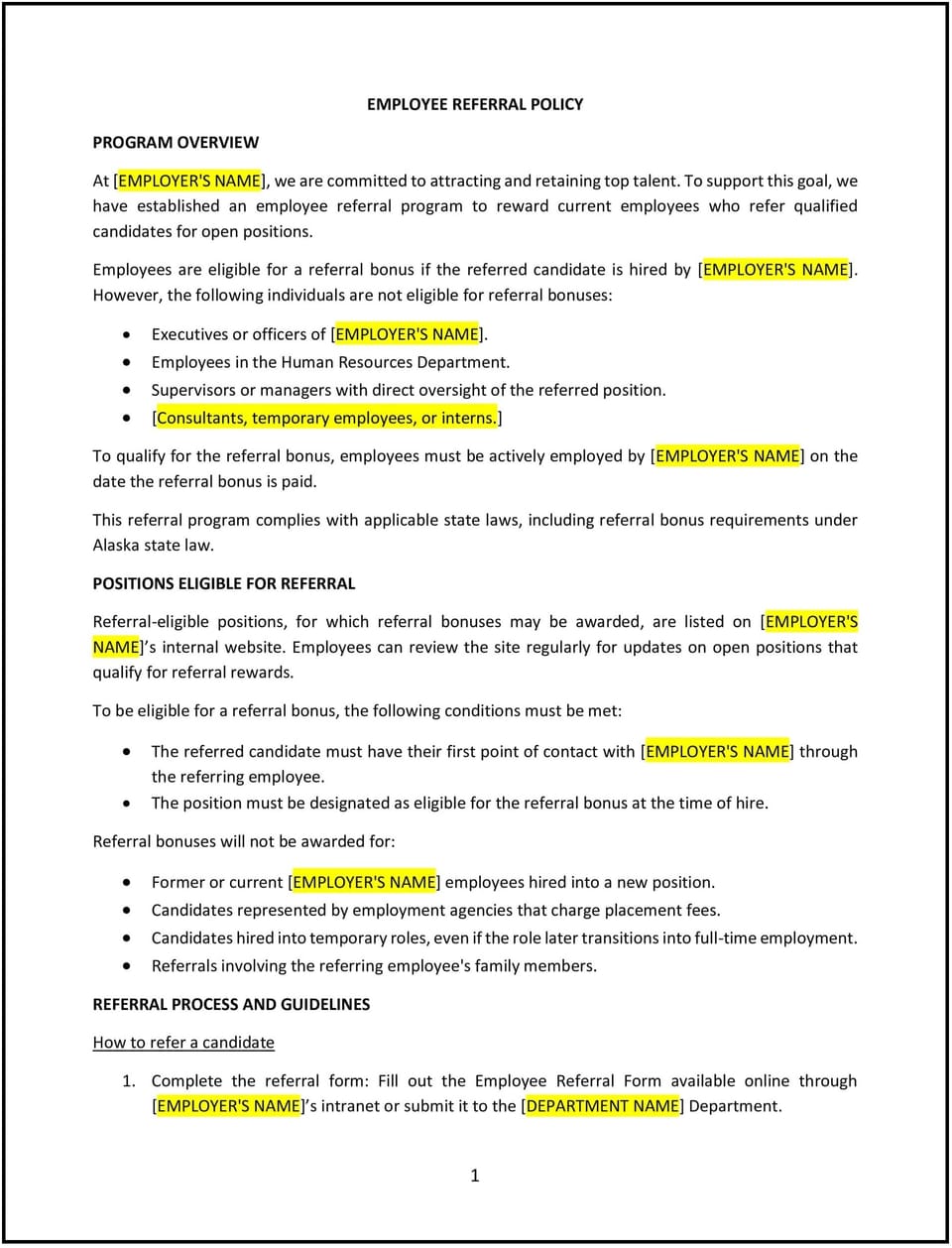Employee referral policy (Alaska): Free template

Employee referral policy (Alaska)
In Alaska, an employee referral policy outlines guidelines for encouraging current employees to recommend qualified candidates for open positions. This policy helps businesses leverage their workforce to identify top talent, fostering a sense of involvement and rewarding employees for successful referrals. By implementing an employee referral policy, businesses can streamline recruitment, reduce hiring costs, and improve the quality of new hires.
Given Alaska’s unique workforce challenges, such as remote locations and industry-specific skills shortages, an effective referral policy can be tailored to address these needs by incentivizing employees to recommend candidates who align with the company’s requirements.
How to use this employee referral policy (Alaska)
- Define eligibility: Clearly outline which employees and referrals are eligible for rewards, ensuring transparency and fairness in the process.
- Establish referral procedures: Provide step-by-step instructions for submitting referrals, including how employees can recommend candidates and where to send resumes or applications.
- Set reward criteria: Specify the rewards offered for successful referrals, such as cash bonuses, gift cards, or extra time off, and define when rewards will be distributed (e.g., after the new hire completes a probationary period).
- Include exclusions: Clarify any restrictions, such as disallowing referrals for immediate family members or roles outside the program’s scope.
- Promote the policy: Regularly communicate the referral program to employees through email, internal portals, or meetings to ensure widespread participation.
Benefits of using an employee referral policy (Alaska)
An employee referral policy offers several advantages for businesses in Alaska. Here’s how it helps:
- Improves hiring quality: Employees are likely to recommend candidates who align with company culture and possess the required skills, leading to better hires.
- Reduces recruitment costs: Saves on advertising and recruitment agency fees by tapping into existing networks for talent.
- Accelerates hiring: Speeds up the recruitment process by identifying qualified candidates quickly through employee recommendations.
- Enhances employee engagement: Involves employees in the hiring process, fostering a sense of responsibility and appreciation for their contributions.
- Addresses regional challenges: Helps businesses overcome workforce shortages by leveraging employees’ local or industry-specific connections.
Tips for using an employee referral policy (Alaska)
- Tailor rewards: Offer incentives that resonate with employees, such as financial bonuses, experiences, or workplace perks, based on feedback and preferences.
- Focus on industry needs: Encourage referrals for hard-to-fill roles or positions requiring specialized skills, particularly in Alaska’s unique industries like oil, fishing, or tourism.
- Ensure clarity: Provide detailed guidelines to avoid misunderstandings about eligibility, rewards, and referral procedures.
- Track program success: Monitor metrics such as the number of referrals, successful hires, and retention rates to assess the program’s effectiveness and identify areas for improvement.
- Regularly review the policy: Update the policy to reflect changes in hiring needs, workforce dynamics, or employee feedback.
Q: Who is eligible to participate in the referral program?
A: All employees are eligible unless otherwise specified, such as HR or hiring managers directly involved in recruitment decisions.
Q: What types of rewards are offered for successful referrals?
A: Rewards may include cash bonuses, gift cards, additional paid time off, or other incentives based on company policy.
Q: When are referral rewards distributed?
A: Rewards are typically given after the referred candidate completes a probationary period or a specified length of employment.
Q: Can employees refer candidates for any position?
A: Employees can refer candidates for roles included in the referral program. Exclusions, if any, should be clearly outlined in the policy.
Q: How can businesses promote the referral program?
A: Use internal communication channels, such as email updates, meetings, or intranet posts, to inform employees about the program and encourage participation.
This article contains general legal information and does not contain legal advice. Cobrief is not a law firm or a substitute for an attorney or law firm. The law is complex and changes often. For legal advice, please ask a lawyer.


